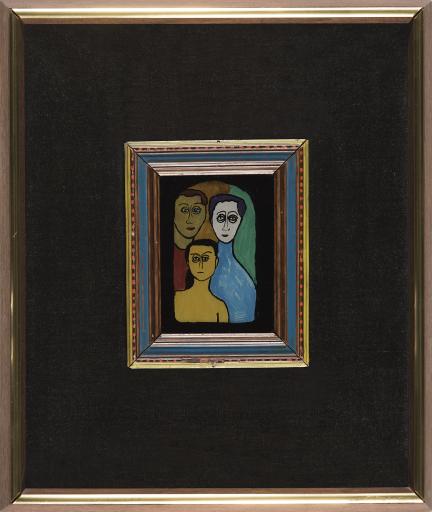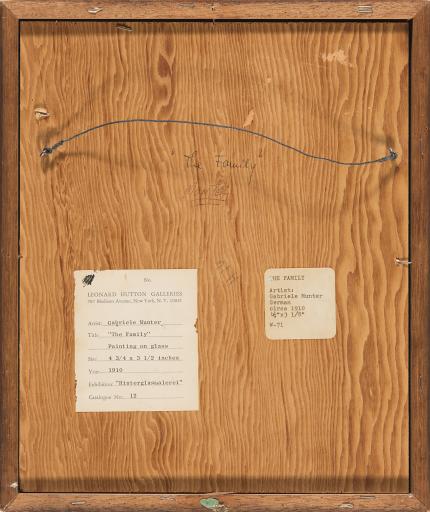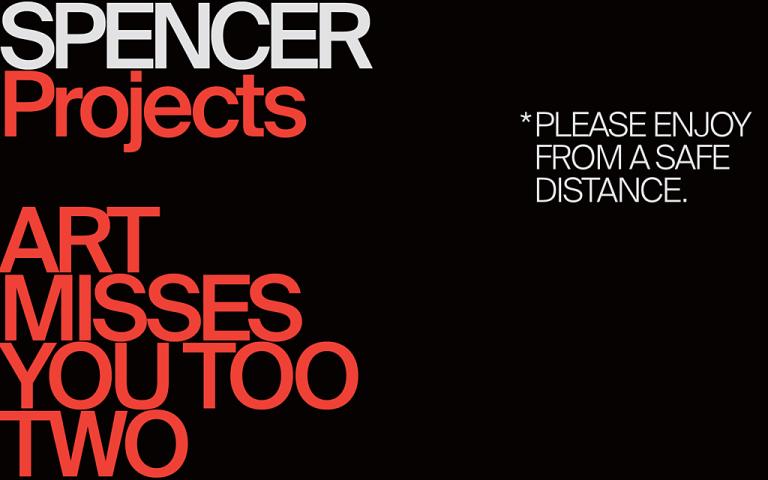The Family, Gabriele Münter
Artwork Overview

If you wish to reproduce this image, please submit an image request
Images
Label texts
This painting is displayed with a group of traditional reverse paintings on glass like those that inspired it. The traditional reverse painting on glass technique requires the artist to paint in an inverted process. The artist begins with painting the finer details on the glass first and then paints the background layers. When the glass is turned over, the viewer can see the layers through the glass in the proper order. Tap the Web icon to see a video of the process. Artist Gabriele Münter, one of the founding members of The Blue Rider art movement, wrote about when she first discovered this technique in a small German village: “We were all enchanted by these works…in Murnau I was the first, as far as I know, in the entire circle who took panes of glass and made some myself…I was fascinated by the technique and how easy it was and constantly told Kandinsky about it in order to inspire him to take it up as well.” This painting may show Münter herself alongside Wassily Kandinsky and Alexej von Jawlenky, two other painters in the Blue Rider Group. (Tap the Web icon to read Münter’s biography or see more work from the Blue Rider Group).
What differences can you see between these reverse glass paintings and other nearby paintings painted on canvas?
This painting is displayed with a group of traditional reverse paintings on glass like those that inspired it. The traditional reverse painting on glass technique requires the artist to paint in an inverted process. The artist begins with painting the finer details on the glass first and then paints the background layers. When the glass is turned over, the viewer can see the layers through the glass in the proper order.
Artist Gabriele Münter, one of the founding members of The Blue Rider art movement, wrote about when she first discovered this technique in a small German village: “We were all enchanted by these works…in Murnau I was the first, as far as I know, in the entire circle who took panes of glass and made some myself…I was fascinated by the technique and how easy it was and constantly told Kandinsky about it in order to inspire him to take it up as well.” This painting may show Münter herself alongside Wassily Kandinsky and Alexej von Jawlenky, two other painters in the Blue Rider Group.
What differences can you see between these reverse glass paintings and other painted works on canvas?
In a personal reminiscence from 1933, Münter describes first learning of reverse-glass paintings in Murnau, a Bavarian village outside of Munich, with fellow artists Alexej von Jawlensky and Wassily Kandinsky. These three artists may be the figures depicted in this painting, an homage to their encounter with the medium. “We were all enchanted by these works…in Murnau I was the first, as far as I know, in the entire circle who took panes of glass and made some myself…I was fascinated by the technique and how easy it was and constantly told Kandinsky about it in order to inspire him to take it up as well.” Inspired to collect and create her own reverse-glass paintings employing the Bavarian techniques and styles, these works provided Münter the opportunity to experiment with the interaction of color among planar fields.
In a personal reminiscence from 1933, Münter describes first learning of reverse-glass paintings in Murnau, a Bavarian village outside of Munich, with fellow artists Alexej von Jawlensky and Wassily Kandinsky. These three artists may be the figures depicted in this painting, an homage to their encounter with the medium. “We were all enchanted by these works…in Murnau I was the first, as far as I know, in the entire circle who took panes of glass and made some myself…I was facinated by the technique and how easy it was and constantly told Kandinsky about it in order to inspire him to take it up as well.” Inspired to collect and create her own reverse-glass paintings employing the Bavarian techniques and styles, these works provided Münter the opportunity to experiment with the interaction of color among planar fields.
Exhibitions
Kate Meyer, curator
Celka Straughn, curator
Kate Meyer, curator
Celka Straughn, curator












